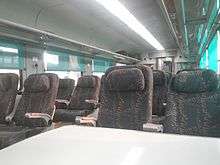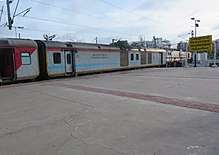LHB coaches
| Linke Hofmann Busch (LHB) coaches | |
|---|---|
| Manufacturer | Linke-Hofmann-Busch |
| Built at | Rail Coach Factory, Kapurthala |
| Specifications | |
| Maximum speed | 200 km/h (120 mph) |


Linke Hofmann Busch (LHB) coaches are the passenger coaches of Indian Railways that have been developed by Linke-Hofmann-Busch of Germany[1] (renamed Alstom LHB GmbH in 1998 after the takeover by Alstom[2] and mostly produced by Rail Coach Factory in Kapurthala, India.[3] They have been used since 2000 on the broad gauge (1676 mm[4]) network of Indian railways. Initially, 24 air conditioned coaches were imported from Germany for use in the Shatabdi Expresses, after which the Rail Coach Factory started manufacturing after technology transfer.[5]
The coaches are designed for an operating speed up to 160 km/h and could go up to 200 km/h.[6] However, they have been tested up to 180 km/h. Their length of 23.54 m and a width of 3.24 m means a higher passenger capacity, compared to conventional rakes.[7] The tare weight of the AC chair car was weighed as 39.5 tonnes.[8] They are considered to be "anti-telescopic", which means they do not get turned over or flip in case of a collision (chiefly head-on). These coaches are made of stainless steel and the interiors are made of aluminium which make them lighter as compared to conventional rakes.[9] Each coach also has an "advanced pneumatic disc brake system" for efficient braking at higher speeds, "modular interiors" that integrate lighting into ceiling and luggage racks with wider windows.[10] The improved suspension system of LHB coaches ensures more riding comfort for the passengers compared to conventional rakes. The air conditioning system of the LHB coaches is of higher capacity compared to the older rakes and is controlled by a microprocessor which is said to give passengers better comfort than the older coaches during summer and winter seasons. They are relatively quieter as each coach produces a maximum noise level of 60 decibels while conventional coaches can produce 100 decibels.
Each LHB coach costs between ₹ 15 million to 20 million, whereas the power car which houses a generator costs about 30 million.[6][11] In 2016, IR declared that all ICF coaches will be replaced by LHB coaches to provide more safety and comfort.
History
During 1993-94, Indian Railways decided to look for a passenger coach design which would be lighter and capable of higher speeds compared to their existing rakes. The main features of the Railways' specification were high speed light weight coaches to run on the present infrastructure of the Indian Railways, i.e. the railway, track and environmental conditions in India at an operating speed of 160 km/h.[4][9] It was decided by the Railways that the design would first be tried in the Rail Coach Factory in Kapurthala (RCF), and upon successful completion of this trial, it would be tried in the Integral Coach Factory in Perambur.[5]
In 1995, after a global selection process, Alstom-LHB received the order from Indian Railways to design and develop a new passenger coach under a transfer of technology agreement.[9] As part of the order, Alstom-LHB had to execute two contracts, one for the supply of "Light Weight High Speed Coaches for Broad Gauge"[4] which includes the development, design and manufacture of 19 AC 2nd Class Chair Cars, 2 AC Executive Class Chair Cars and 3 Generator-cum-Brake vans[12] and the other contract for the "Technology Transfer" which includes the transfer of technology for design and manufacturing, the training of Indian Railways personnel in the premises of the manufacturer and the technical assistance at RCF during the start of production.[5]
Out of the 24 coaches imported from Germany, all of them mostly being Air Conditioned chair cars,[13] the first lot were used for New Delhi-Lucknow Shatabdi Express on a trial basis. It didn't turn out be successful as the coaches' wide windows were targets of mischief and stone-pelting. Railways had to use sealing tapes to tape up the bruised windows.[9] When these rakes were brought into service, couplers came unstuck and the data collected from the passenger feedback showed that the air conditioning was not "very effective". They were withdrawn from service and after attending to the problems, Railways reintroduced them on the New Delhi-Lucknow Shatabdi Express and proved successful.[9][14]
The RCF began to manufacture other variants of LHB design like the air conditioned first class, AC 2 tier sleeper, AC 3 tier sleeper, hot buffet (pantry) car etc., from 2001 to 2002, and rolled out its first rake in December 2002. The first such rake was introduced for Mumbai-New Delhi Rajdhani Express in December, 2003.[13] Up to March 2011, 997 LHB coaches were produced by the RCF.[15][16] All of these coaches are being used in premier super fast express trains like Rajdhani, Shatabdi and Duronto Express and have been offering better passenger comfort.[17] Soon, all the Duronto trains will be equipped with LHB coaches.[18]
Production
Annual production of LHB coaches is around 400 per year for year 2013-2014.[19]
- During 2010-11, RCF Kapurthala produced 300 coaches.[20] During 2012-13, the total number of coaches that were produced was 1680, while in 2013-14, RCF was able to increase the production to 1701 coaches.[21]
- During 2013-14, Integral Coach Factory produced 25 LHB coaches.[22] It plans to increase its manufacturing capacity of LHB coaches. It has set a target to manufacture 300 LHB coaches in 2014-15 and reach a capacity of 1000 LHB coaches by 2016-17.[23]
- The planned capacity of Rail Coach Factory, Raebareli is 1000 LHB coaches per year.[19] The plant is yet to become fully operational.
- A rail coach factory has been sanctioned at Palakkad, Kerala in public private partnership mode for production of LHB coaches.[24] Once completed, this factory would produce 400 coaches annually.[25]
Types
| Coach Type | Class | Sleeping
Capacity |
Sitting
Capacity |
|---|---|---|---|
| LWFAC[27] | 1A | 24 | 24 |
| LWACCW[27] | 2A | 54 | 54 |
| LWFCWAC[28] | 1A/2A | ||
| LWACCN[27] | 3A | 72 | 72 |
| LWSCN | SL | 80 | 80 |
| LWFCZAC[27] | EC | - | 56 |
| LWSCZAC[27] | CC | - | 78 |
| LWSCZ | 2S | - | 78 |
| LGS/LS | UR/GEN | - | 100 |
| LWCBAC | PC | - | - |
| LWLRRM | EOG | - | - |
References
- ↑ "New-look train to Delhi rolls out". Times of India. 22 Apr 2012. Retrieved 5 Sep 2012.
- ↑ "History". Alstom. Archived from the original on 18 February 2013. Retrieved 5 September 2012.
- ↑ "Fastest train 'Duronto' is slow off the blocks". The Hindu. 31 Mar 2012. Retrieved 5 Sep 2012.
- 1 2 3 "Improvement in Secondary Suspension of "IRY-IR20" Coach using Adams/Rail" (PDF). 'Rail Coach Factory. Retrieved 8 Sep 2012.
- 1 2 3 "New AC coaches inducted into Railways". Indian Express. 17 Mar 2000. Retrieved 8 Sep 2012.
- 1 2 "LHB coaches saved Rajdhani passengers". Times of India. 25 Mar 2010. Retrieved 5 Sep 2012.
- ↑ "Bogie boost for Rajdhani & Shatabdi". The Telegraph. 14 May 2012. Retrieved 5 Sep 2012.
- ↑ "OBJECTIVES OF THE NEWTECHNOLOGY". Scribd. Retrieved 5 Sep 2012.
- 1 2 3 4 5 "New coaches for Mumbai Rajdhani". Business Line. 19 May 2003. Retrieved 8 Sep 2012.
- ↑ "New-look coaches likely in Shatabdi Exp". Times of India. 29 Jun 2009. Retrieved 21 Sep 2012.
- ↑ "Old rake allotted to Duronto Express". The Hindu. 24 Apr 2012. Retrieved 5 Sep 2012.
- ↑ "ALSTHOM coaches". IRFCA. Retrieved 6 Sep 2012.
- 1 2 "Rolling Stock" (PDF). Indian Railways.
- ↑ "Imported coaches ready to hit the tracks". The Hindu. 12 Nov 2001. Retrieved 8 Sep 2012.
- ↑ "RCF produces 597 LHB Coaches". Press Information Bureau, Govt. of India. 16 Jul 2009. Retrieved 7 Sep 2012.
- ↑ "Induction of Linke Holfman Bush coaches at snail's pace". Times of India. 10 Aug 2012. Retrieved 7 Sep 2012.
- ↑ "Railways to opt for LHB coaches in all trains". Orissa TV. 22 Apr 2011. Retrieved 7 Sep 2012.
- ↑ Press Trust of India . "Railways to increase rolling stock output", Business Standard, New Delhi November 7, 2013. Retrieved on 11 November 2013.
- 1 2 "Production of LHB Coaches on Indian Railways". Pib.nic.in. 2014-02-21. Retrieved 2018-05-10.
- ↑ "Kapurthala gets order to make 693 'better' coaches". Indian Express. 10 May 2012. Retrieved 21 Sep 2012.
- ↑ . Press Trust of India. 11 April 2014 http://www.ptinews.com/news/4597981_RCF-achieves-highest-ever-coach-production-in-2013-14.html. Retrieved 20 April 2014. Missing or empty
|title=(help) - ↑ "ICF produces record 1,622 coaches - Times of India". Timesofindia.indiatimes.com. 2014-04-01. Retrieved 2018-05-10.
- ↑ "Indian government approves Kolar coach factory". Railjournal.com. 2014-03-12. Retrieved 2018-05-10.
- ↑ "Print Release". Ministry of Railways. 6 Dec 2012.
- ↑ "Cabinet approves rail coach factory in Palakkad". Business Line. 16 Feb 2012. Retrieved 23 Jan 2013.
- ↑ BS Reporter. "Cabinet approves rail coach factory at Kolar | Business Standard News". Business-standard.com. Retrieved 2018-05-10.
- 1 2 3 4 5 "Rlys may raise stainless steel coach production". Business Line. 22 Jun 2007. Retrieved 6 Sep 2012.
- ↑ "Condonation of infringement to maximum dimensions of Composite (AC Ist + AC-2 Tier) EOG LHB Variant Coach (LWFCWAC) to IRSOD (BG) Revised, 2004" (PDF). Indian Railways. 2013-02-25. Retrieved 2016-04-16.